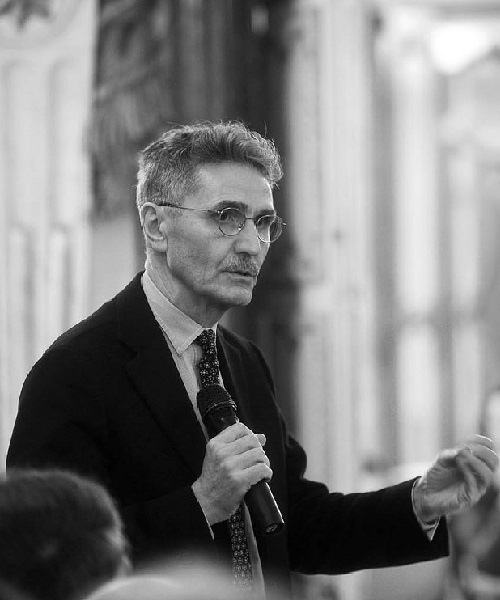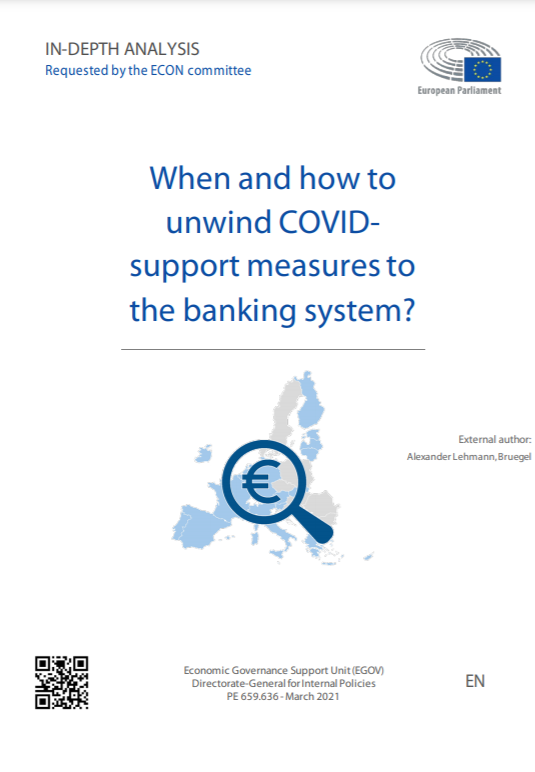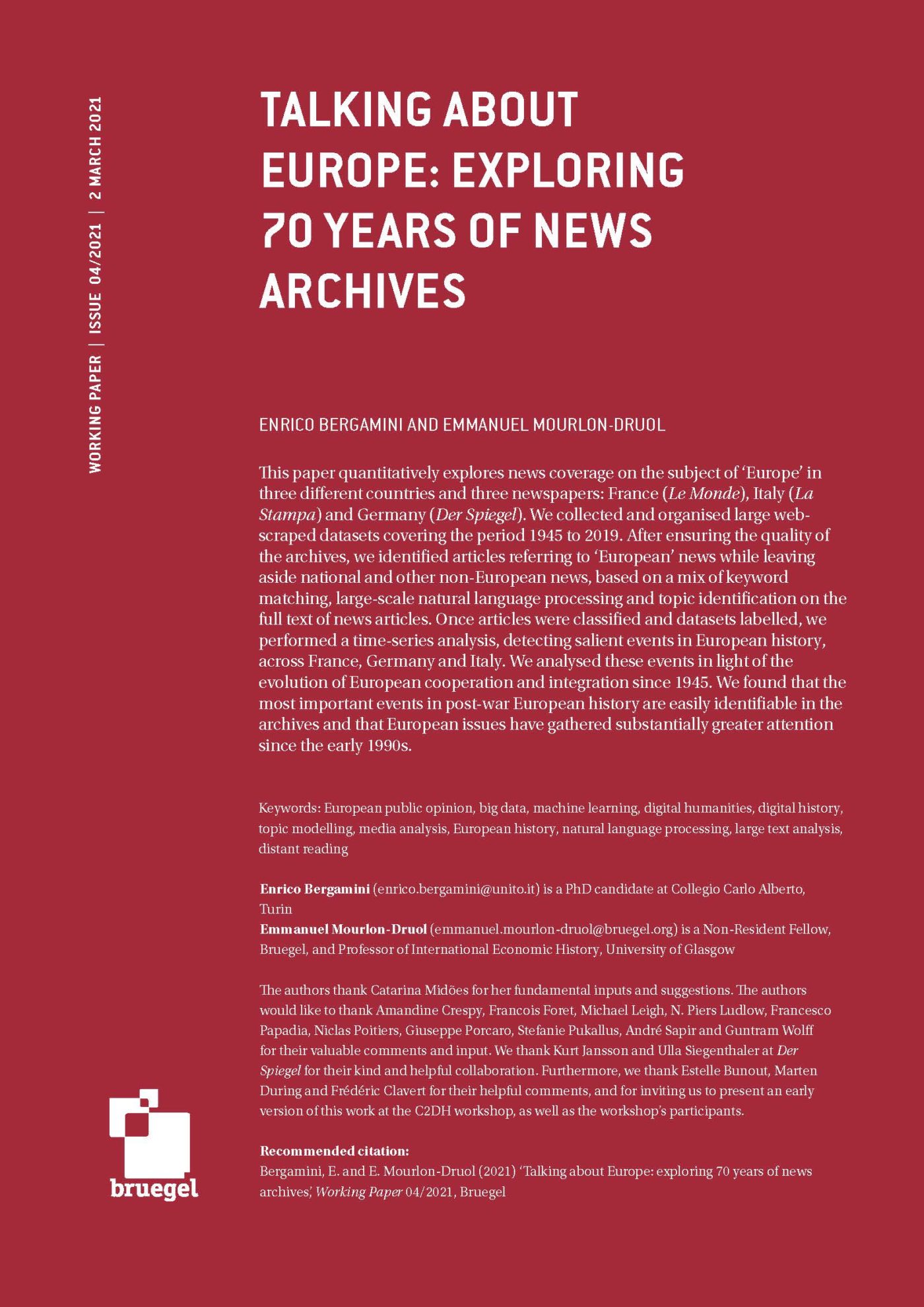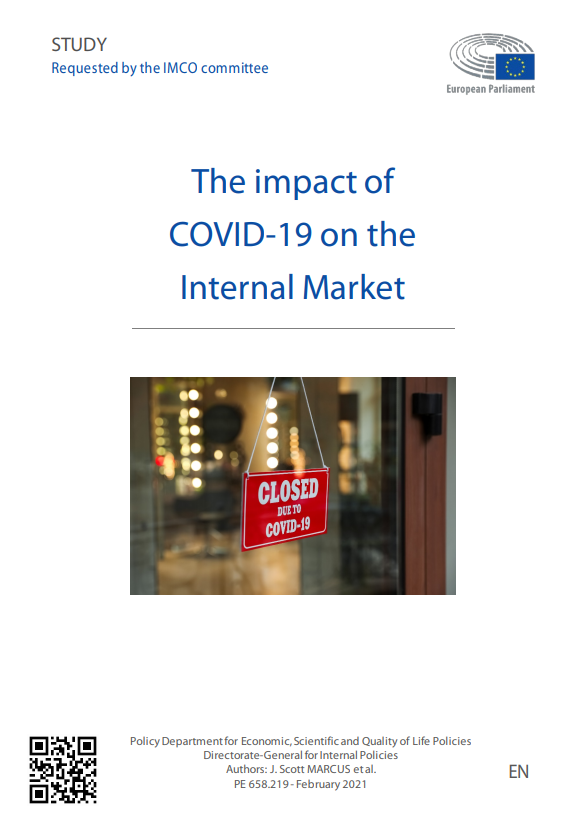Blog Post
Do citizens care about Europe? More than they used to
The level of interest of European citizens in the European Union is increasing, but still lags behind EU economic and policy integration.
There is a persistent narrative about the European Union according to which progressive European unification is an endeavour pursued by elites against the wishes, or at least without the support, of a majority of the population. The ongoing Conference on the Future of Europe, aimed at increasing popular debate about European integration, is the latest attempt to get to grips with this narrative. The implications of the narrative, combined with another about the insufficient public governance of EU economic integration, are that the European construction lacks proper democratic foundations and that it is intrinsically fragile in the face of shocks.
Of course, supporters of European integration stress that, over the decades, the EU has not only survived and grown but has also confirmed founding father Jean Monnet’s prophecy that Europe would be built on the back of solutions to its recurrent crises. This is a strong argument, but not strong enough, because European integration has become more and more pervasive and the question of whether it has solid democratic foundations remains critical.
Low turnout in European elections is often cited as proof of citizens’ limited support of, or even interest in, the European project. European election turnout is typically lower than in national elections, notwithstanding the increase of eight percentage points in the 2019 European election, to 50.7%. But this quantitative evidence does not seem strong enough to reach convincing conclusions about public engagement with the EU. Complementary measures of European integration and the interest of European citizens in European affairs can give quantitative evidence to confirm, or disprove, these narratives (details of our research on this can be found here and here).
Economic integration is the easiest variable to measure. Trade integration, measured as intra-European trade relative to GDP, can be tracked back over a half a century (Figure 1).
Figure 1: Intra-European Union trade as a percentage of EU GDP (1970-2018)
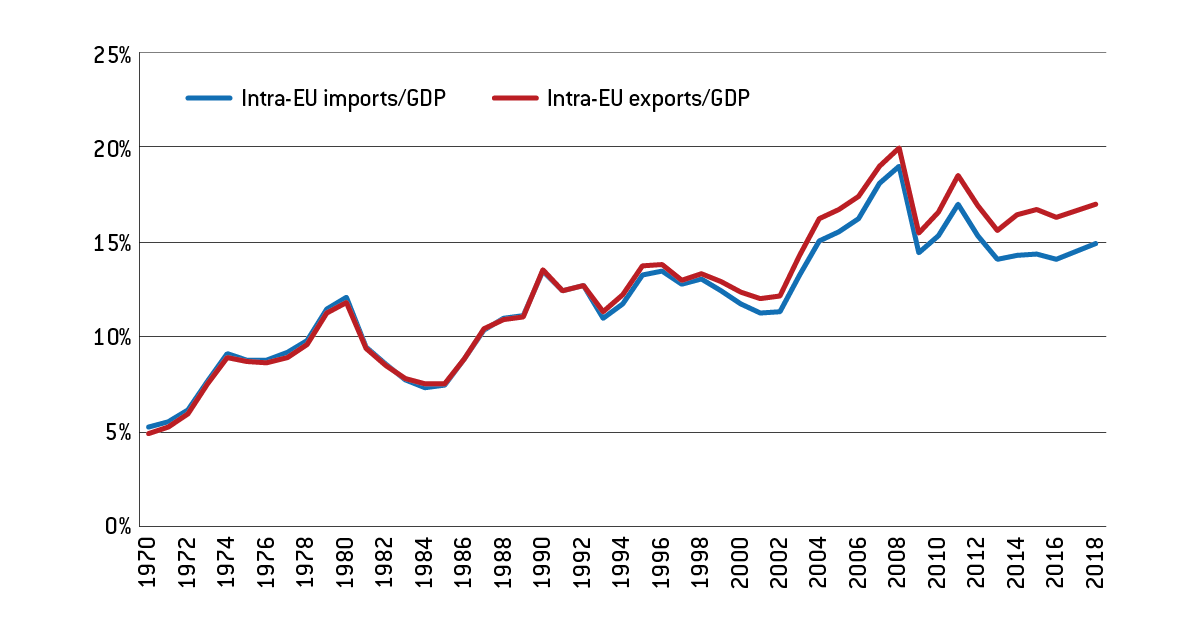
Source: Figure 3 in Papadia and Cadamuro (2020).
Figure 1 shows an increase in intra-European trade relative to GDP from 1970 up to the Great Recession, but no clear trend since. Over the entire period, trade as a share of GDP increased from 5% to 15% or slightly more, thus increasing by a factor of about three. Another measure of economic integration, financial integration (measured by cross border capital flows relative to total financial size), can only be measured over the last two decades and increased over this period by about 60%.
Another integration measure is policy integration, or the amount of policy and administrative action taking place at European rather than national level. This is harder to measure than economic integration, but the number of European public employees relative to the aggregate number of national employees can be used as a proxy, assuming that one public employee at European level carries out the same amount of policy and administrative work as a national public employee.
Figure 2 shows that the number of employees in European public organisations remains a very small fraction of the number of employees in national public organisations, but in percentage terms this fraction has increased by a factor of about eight, a significant increase in relative importance.
Figure 2: European public employees as a percentage of total national public employees (1970-2018)
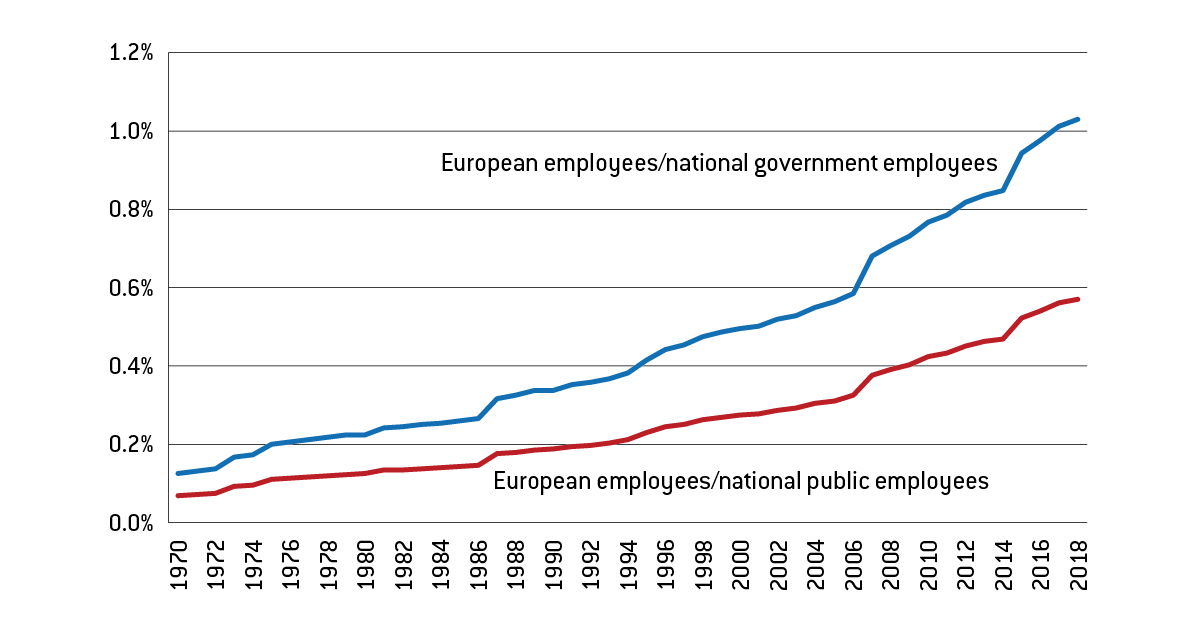
Source: Figure 6 in Papadia and Cadamuro (2020).
Meanwhile, three proxies can be used to measure changes in the level of interest of European citizens in European affairs:
- Turnout at European Parliament elections relative to national elections (Figure 3);
- Eurobarometer surveys on interest in European politics/attachment to Europe relative to one’s country (Figure 4);
- The presence of European news relative to total news in three elite newspapers (Figure 5).
Figure 3: European Parliament elections turnout relative to turnout in national elections (1979-2019)
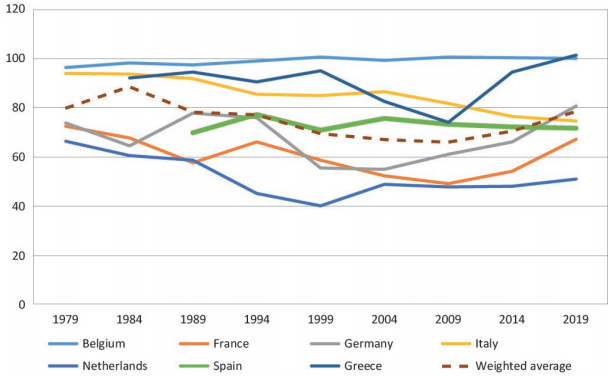
Source: Figure 1 in Papadia et al (2021).
Figure 3 shows three phenomena:
- With the exception of Belgium, which has compulsory voting and synchronises its elections calendar with European elections, and Greece in the most two recent observations, turnout is lower in European elections than in national elections, in some cases much lower. On average for the selected countries, at the end of the period participation in European elections was close to 80% of participation in national elections.
- Relative turnout per country is quite different, with the Netherlands and France on the low side and Belgium, Greece, Italy and Germany on the high side.
- Average relative turnout tended to fall over the first two or three decades in which direct European Parliament elections took place, and then stabilised, before increasing more recently.
The usual interpretation that a low level of European election turnout is a sign of voter disinterest in the EU itself needs qualification. While turnout in European elections is certainly below most national elections in Europe, it has often been in the range of, for example, US mid-term elections to the House of Representatives. European election turnout has even been above turnout in Swiss federal elections in all years but 2009 and 2014. The latter case could be explained by Swiss citizens attaching relatively less importance to federal elections because they frequently vote in referendums. In a semi-parallel to the Swiss situation, voters may perceive European elections as less important because EU decisions need to go through the Council of the EU as well as the European Parliament.
Figure 4: Interest in European politics/attachment to Europe (1973-2019), Eurobarometer surveys
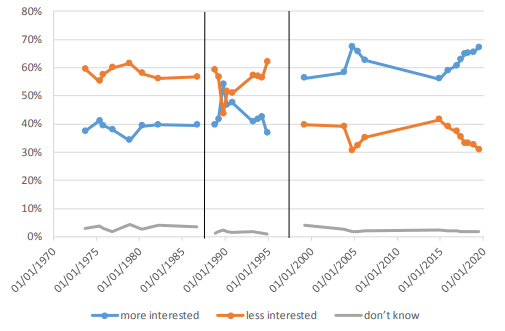
Source: Figure 3 in Papadia et al (2021).
An overall reading of Figure 4 shows no trend change in the level of public interest in European politics between 1975 and 1994, and a significant, yet irregular, increase in attachment to Europe only over the last two decades, coinciding, not surprisingly, with the introduction of the euro and EU enlargement.
The vertical lines represent changes in the phrasing of the question in Eurobarometer surveys: in the first two panels the question relates to ‘interest in EU politics’, but in the second panel an added additional option was available as an answer (‘to some extent’, that we split between ‘more interested’ and less interested, for the ease of reading); in the final panel the question relates to ‘attachment to Europe’.
Figure 5: Frequency of European news relative to total news, selected European newspapers (1945-2018)
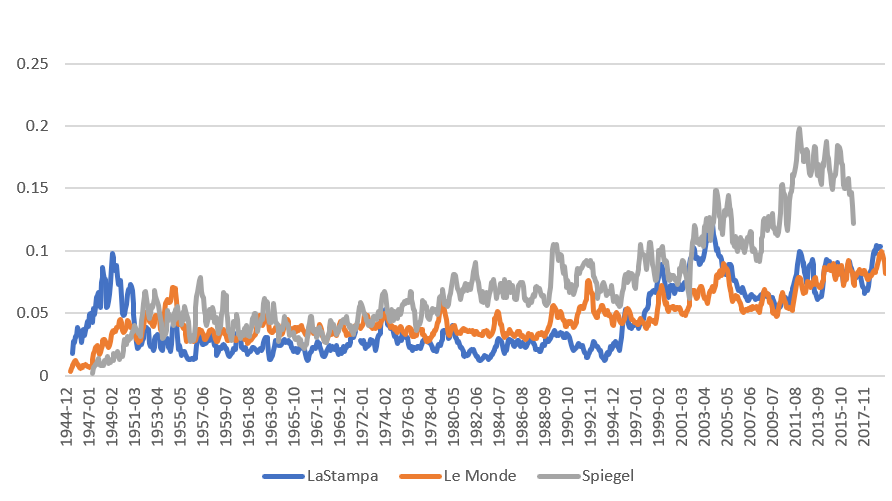
Source: Figure 5 in Papadia et al (2021). For details on the construction of the series see Bergamini and Mourlon-Druol (2021). For details on the individual newspapers, see blog posts on Le Monde, Die Zeit and Der Spiegel, and La Stampa.
Figure 5 shows European news as a share of total news in three selected newspapers (Le Monde, La Stampa, Der Spiegel). These are elite newspapers, but still indicative of more general public opinion changes at national level. Overall, there has been a significant increase in the frequency of European news since the 1940s in all three newspapers:
- Le Monde included about two articles about Europe out of 100 in the 1940s; the percentage increased about fourfold to around 8% in the 2010s;
- The frequency of European news in Der Spiegel increased by a factor of around six, from about 2% to more than 12%;
- The frequency of European articles in La Stampa increased about fivefold over the period.
Overall, there has been much variability in the level of European news, with some distinct peaks and troughs, which in most cases can be connected with European events, but there is evidence of a more sustained level in recent decades, broadly coinciding with the introduction of the euro.
Reaching clear conclusions from all this evidence is not straightforward. However, overall, the picture is of policy and administrative integration at European level growing even beyond economic integration. The fear that an integrated private sector has outstripped the ability of the public sector to govern the economy is not confirmed by our data. However, the interest of citizens in Europe, while growing, especially since the introduction of the euro, has not kept pace with economic and policy integration. We cannot, therefore, discard the view that European integration still has a technocratic character and European citizens are still not sufficiently engaged. It is true that interest in European affairs (as identified in Eurobarometer surveys and the relative turnout in European Parliament elections) has grown to a level of about three quarters of interest in national affairs, but arguably it remains insufficient given the levels of economic and policy integration, while the increase in the frequency of European news relative to total news has not kept track with the increase in economic and policy integration.
The new Conference on the Future of Europe has the goal of “giving citizens a greater role in shaping EU policies and ambitions”. This goal is fully justified. Time will tell if, this time, it will be achieved.
Recommended citation:
Bergamini, E., E. Mourlon-Druol, F. Papadia and G. Porcaro (2021) ‘Do citizens care about Europe? More than they used to’, Bruegel Blog, 26 April
Republishing and referencing
Bruegel considers itself a public good and takes no institutional standpoint. Anyone is free to republish and/or quote this post without prior consent. Please provide a full reference, clearly stating Bruegel and the relevant author as the source, and include a prominent hyperlink to the original post.



